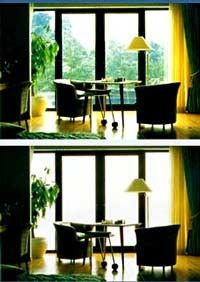In 1888, Theophilus van Kannel patented the revolving door, an invention he claimed would prevent "noxious effluvia" and "baleful miasmas" from entering a building when someone like the postman came and went [source: Guardian.co.uk]. Conveniently, the revolving door also eliminated the need for one person to hold a door open for another (legend has it that Van Kannel had grown tired of opening doors for his traditionally-minded wife).
But the revolving door wasn't the only thing van Kannel invented for the purpose of keeping cold air and pollutants out of buildings. His sophomore inventing effort was the air curtain, which he patented in 1904 and which was eventually installed for the first time in a building in 1916 [source: Miniveil.com]. To put it simply, an air curtain is a continuous stream of air blown from the top to the bottom of an open doorway. Commonly used as a second line of defense inside a closed door or to replace hanging plastic flaps in an open doorway, air curtains form a barrier that people and products can flow across, but air can't. This means that the climate on one side of the air curtain doesn't shake hands with the climate on the other.
Advertisement
The air curtain does two things: First, it insulates, and we all know the insulating power of air. It's the layer of air trapped between double-pane windows that keeps heat from moving across them. (What? Did you think it was the doubled thickness of the glass?) Secondly, an air curtain used as backup inside a door can be angled to blow outside air back out from whence it came.
Though an invisible curtain of air may sound like a Star Trek approach to Enterprise efficiency, if installed and used correctly, an air curtain can increase energy efficiency and keep pollutants and insects out of an open doorway.
Advertisement




